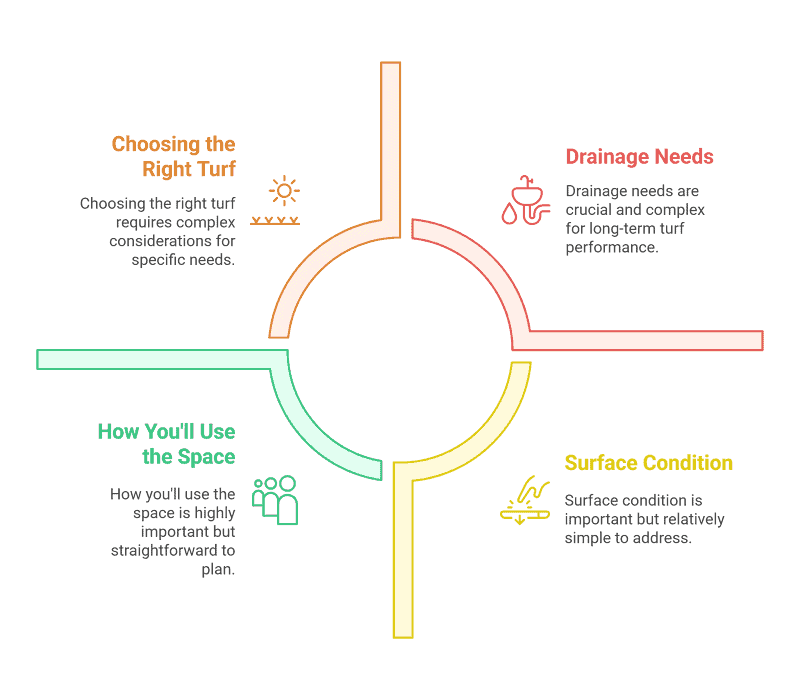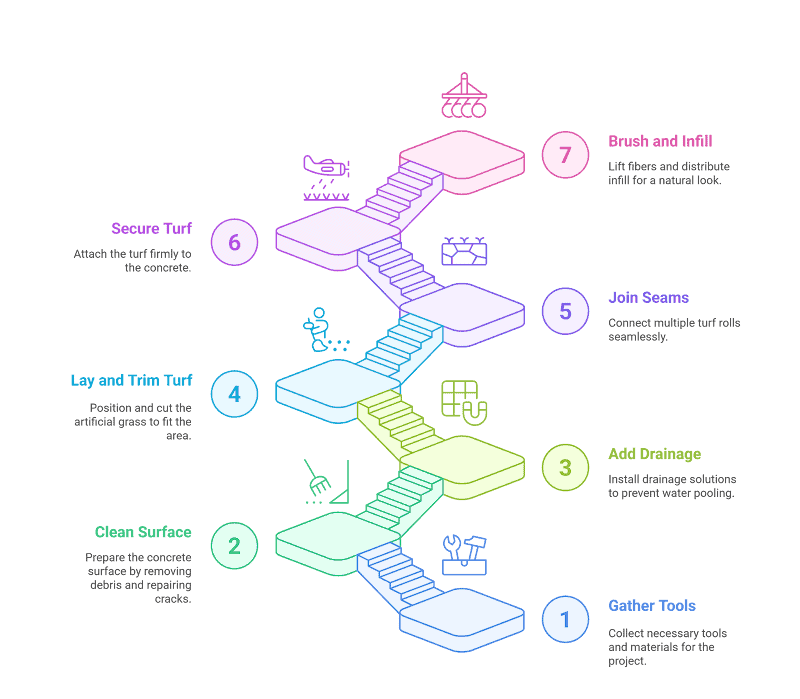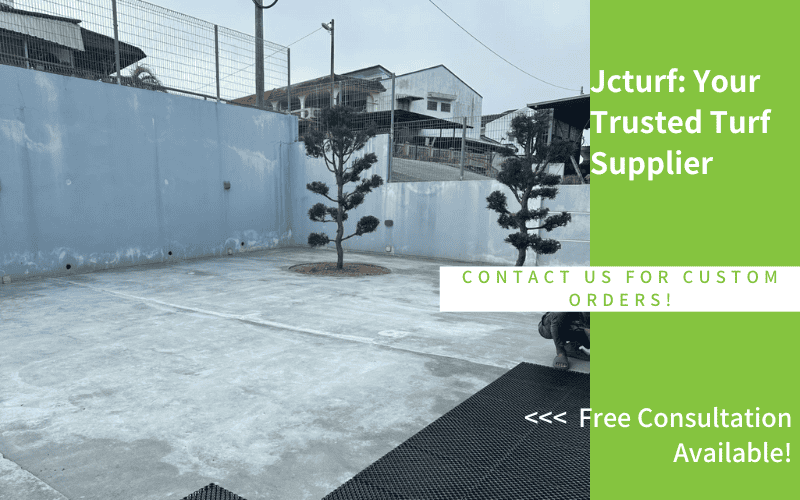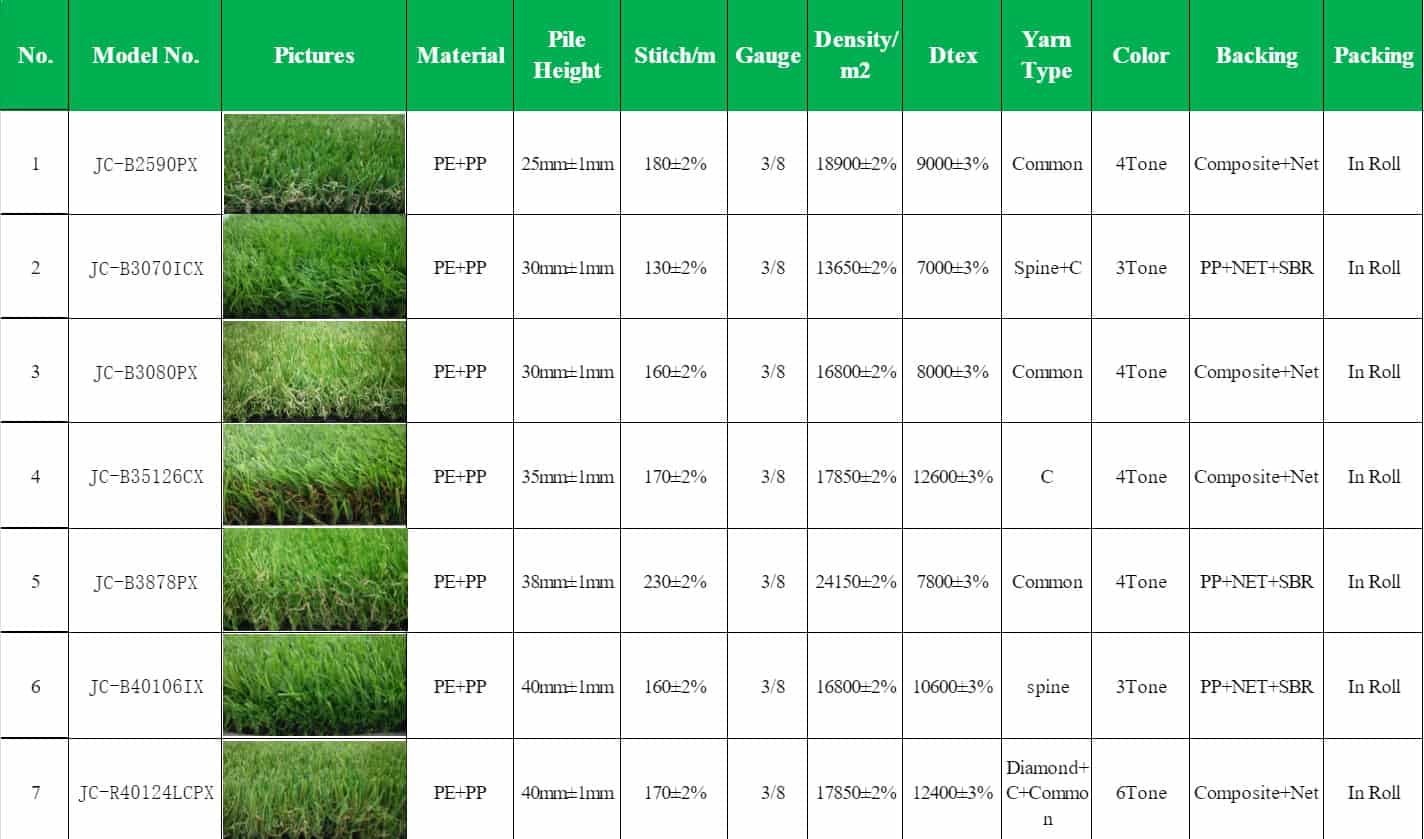Thinking of transforming that dull concrete patio or balcony with artificial grass? It’s totally possible — and easier than you might think. But before you roll out the turf, it’s important to understand how well it works, what to prepare, and what to avoid.
In this guide, we’ll cover whether turf can really be installed on concrete, the pros and cons, key things to check before starting, and how to install it step by step. You’ll also learn how to handle drainage, make it safe for dogs, and avoid common mistakes. Let’s make sure your concrete surface turns green — the right way.
Is It Possible to Install Artificial Grass on Concrete?
Yes, you can install artificial grass on concrete. It’s a practical solution for patios, balconies, rooftops, and even driveways. In many cases, it works surprisingly well.
But there are a few things you need to check first. The concrete surface should be clean, dry, and as level as possible. Small cracks are fine, but deep holes or uneven areas can cause problems. Artificial turf needs a stable surface to look and feel right.
Drainage is another key point. Unlike soil, concrete doesn’t absorb water. If your space tends to collect puddles, you’ll need a way for water to escape. Most people add drainage holes or place a special drainage mat under the turf to keep the surface dry and safe.
Installing turf over concrete is often faster and less messy than digging up soil. You won’t need to remove anything — just prepare the surface and lay the turf correctly. When done properly, it feels soft underfoot, stays in place, and lasts for years.
So yes — artificial grass can go on concrete, and with the right prep, it’s a smart, low-maintenance way to bring greenery to hard surfaces.
Pros and Cons of Laying Turf Over Concrete
Laying artificial grass on concrete has real advantages, but it’s not the best fit for every space. Here’s a quick look at the key pros and cons to help you decide:
Pros:
- Easy and mess-free setup: No digging required, and concrete works as a ready base.
- Great for hard-to-use areas: Ideal for balconies, patios, rooftops, and driveways.
- Low maintenance: No mowing, watering, or fertilizing needed.
- Instant green upgrade: Quickly transforms dull concrete into a fresh, natural look.
Cons:
- Less cushioning underfoot: The surface feels firm unless you add a foam pad or shock layer.
- Drainage issues: Water may pool without a drainage mat or drilled holes.
- Heat retention: Turf can get hot under strong sunlight, especially in summer.
- Permanent fixes needed: Turf must be glued or taped down to stay secure.
Think about how you’ll use the space, who will use it, and what kind of prep you’re willing to do. These pros and cons can guide you toward the right setup for your needs.
Key Considerations Before You Install Artificial Grass on Concrete
Before installing artificial grass on a concrete base, you need to check a few key things: the surface condition, how drainage will work, how the area will be used, and which type of turf is best for your needs. These basic checks help you avoid mistakes and ensure long-term performance.

Surface Condition
The concrete must be clean, flat, and free of major cracks or dips. A smooth base helps the turf stay even and secure. Also, check if the edges are well-defined — a wall, curb, or physical boundary makes it easier to anchor the turf and prevent lifting over time. Any loose gravel, broken corners, or surface bumps should be repaired in advance.
Drainage Needs
Concrete doesn’t absorb water. If the area tends to hold puddles, you’ll need a drainage plan — like adding drainage holes or installing a permeable pad underneath the turf. Also check the slope direction. If the water can’t flow off the surface easily, pooling and odor can become long-term problems.
How You’ll Use the Space
Are you planning to walk on it daily, play with pets, or just want a visual upgrade? Heavy foot traffic or active kids may require a foam underlay for added softness and shock absorption. Knowing how the space will be used helps determine the right base and accessories.
Choosing the Right Turf
Not all synthetic grass products are the same. Look for turf with drainage backing, UV protection, and soft blades if comfort matters. If your concrete gets very hot in the sun — especially darker surfaces — consider heat-resistant turf or plan to add shade.
How to Install Artificial Grass on Concrete (A Quick View)
Installing artificial grass on concrete is totally doable — even if it’s your first time. Below is a fast but complete 7-step guide: from gathering tools and preparing the base, to trimming, gluing, brushing, and finishing. These basics will help you avoid the most common mistakes and get great results.

1. Gather Tools and Materials
You’ll need a broom, utility knife, strong outdoor glue or turf tape, a stiff brush, and gloves. Materials may include shock pads, drainage mat, seam tape, and infill. Prep everything before starting.
2. Clean and Check the Surface
Sweep the concrete and remove debris, dust, oil, or loose patches. Repair cracks if needed. The cleaner and flatter the base, the better the turf will stick and drain.
3. Add Drainage and Underlay (If Needed)
Drill holes or place drainage mats if water tends to pool. For comfort, especially in play areas, add foam underlay or shock pads before laying turf.
4. Lay and Trim the Turf
Roll out the grass and let it relax under the sun for a few hours. Trim edges to fit using a sharp knife. Keep blade direction consistent for a natural look.
5. Join the Seams
If using multiple turf rolls, align the edges closely and apply turf seam tape or glue underneath. Press firmly so the seam disappears. Misaligned seams are hard to fix later.
6. Secure the Turf
Use outdoor adhesive or double-sided turf tape along all edges and seams. Press the turf down firmly. Corners are especially important — secure them well to prevent lifting.
7. Brush, Infill, and Let It Set
Brush the turf with a stiff broom to lift fibers and distribute infill if used. Then wait a few hours (or as per glue instructions) before walking on it. Let everything settle properly.
Does Artificial Grass Drain Well on Concrete?
Artificial grass does not drain well on concrete unless drainage is added underneath. Most turf products have a perforated backing that allows water to pass through, but concrete itself is not absorbent. Water can’t soak in, so it stays on the surface unless you create a way for it to escape.
If your concrete patio or driveway already has a good slope, water may run off naturally. But in many cases — especially on flat rooftops or balconies — water tends to collect beneath the turf. This can lead to bad smells, mold, and even cause the turf to lift over time.
To prevent this, you’ll need a drainage solution. That might mean drilling small holes into the concrete or adding a drainage mat underneath the grass. In wet climates or high-use areas, combining both is a good idea. These steps help move water out quickly and protect your turf long-term.
In short, synthetic turf only drains well if the concrete underneath allows it. Good drainage starts from the base — not just the grass.
Is Artificial Grass on Concrete Safe for Dogs?

Yes — artificial grass on concrete is generally safe for dogs, as long as a few conditions are met. The turf itself is non-toxic and durable, making it fine for pets to walk, lie, or play on. But comfort and hygiene depend on proper installation and maintenance.
First, the surface can feel hard without a foam underlay, which may not be ideal for older dogs or those with joint issues. A shock pad can help soften the ground and improve traction.
Second, dog urine won’t absorb into concrete, so it’s important to rinse the area regularly. Choosing turf with antimicrobial backing also helps prevent odors.
On hot days, synthetic grass can heat up fast. If your dog spends a lot of time outdoors, consider adding shade or using heat-resistant turf varieties.
In short, artificial turf can be a pet-friendly surface — just make sure it’s built with their comfort in mind.
Common Misconceptions About Turf Over Concrete
When installing artificial grass on concrete, some common assumptions can lead to poor results or even failure. If you’re new to turf projects, watch out for these frequent misunderstandings — they’re easy to fall into but just as easy to fix.
“You can just roll it out and you’re done.”
Not quite. Without cleaning, trimming, securing, and addressing drainage, your turf will shift, wrinkle, or trap water. Proper prep is essential.
“All artificial grass works the same.”
Different turfs serve different needs. Some are softer, some drain better, and some are built to resist heat. Choosing the right type matters.
“Concrete drains water anyway.”
Actually, it doesn’t. Concrete holds water unless you add drainage holes or layers. Assuming otherwise causes pooling and odor.
“Glue is optional.”
Turf needs to be firmly fixed to prevent lifting. Skipping adhesive or tape may save time now, but leads to costly fixes later.
Final Thoughts: Is It Right for Your Space?
Artificial grass on concrete can be a smart upgrade — but only if your space meets the right conditions. Ask yourself: Is the surface flat? Can water drain properly? Do you need softness for kids or pets? If the answer is yes, you’re likely a good candidate.
It’s not just about laying turf; it’s about doing it right. With the right prep and materials, you can turn even a dull patio or balcony into a clean, low-maintenance green zone.


